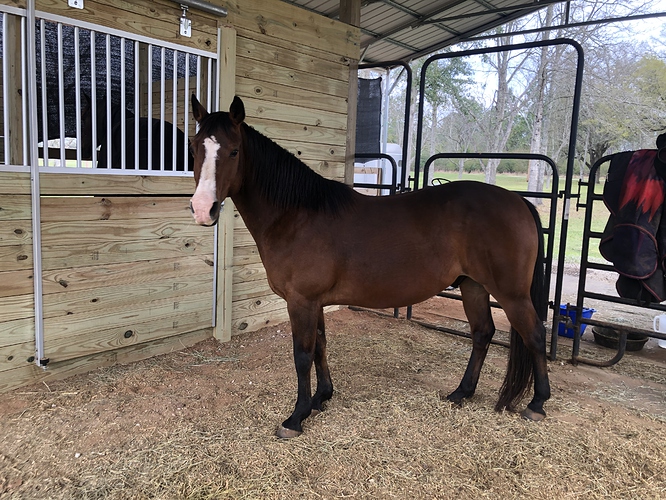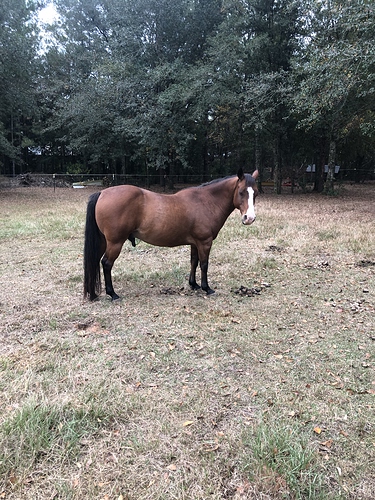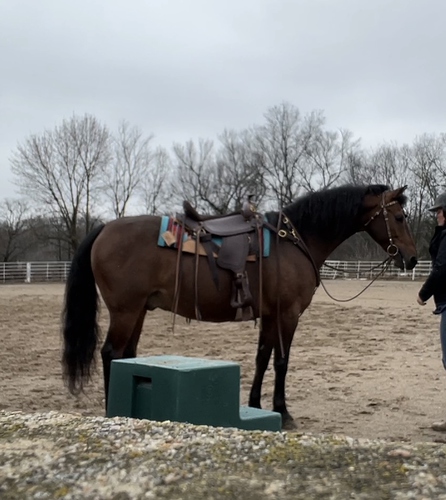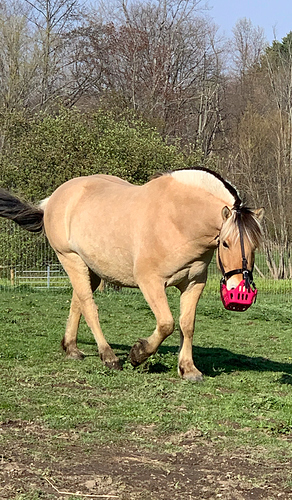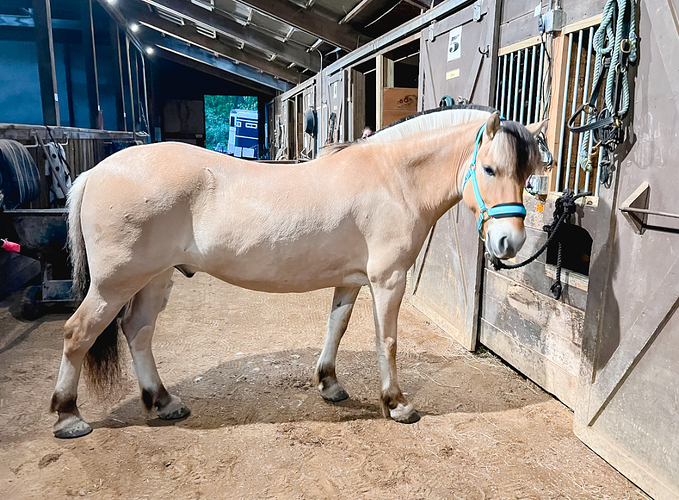That’s why he just got a taste test. I’ll have to report back once we get a bale of the Stand-lee stuff.
I now declare this the thread of the Fatty Fatty McFattersons and we should all provide updates here on the metabolically challenged equines in our lives!
Seriously - I’m Happy to hear of anyone’s positive experiences  this thread is perfect for it.
this thread is perfect for it.
I skimmed this thread and will add that I own a fatty fatty mcfatterson… ette? It is very tough to manage them when they live with other horses that are fine on free choice food. If I had multiple fatties then I would do things differently but with her current living situation this is what kind of works:
- when shes outside with her friends they have a 1.25" net with good quality hay (she also is able to eat through this net with a muzzle on too if necessary)
- when shes in her stall she gets poorer quality hay (its borderline straw) in a 1" hay pillow, I see a big difference with how she looks when she’s regularly being brought in overnight compared to when she just stays out 24/7 on the good hay in the slightly bigger net
- always muzzled when on grass (thinline or greenguard), i actually find she maintains a better weight when she gets some time in a pasture with a muzzle because she moves around a lot more
- no grain, not even a commercial ration balancer - she gets a vitamin/mineral mix in some plain beet pulp
- if things get out of hand … i use levothyroxine for a few months to bring her weight down
I will also add I put her on a ritzy state of the art track system for a few months and she was borderline the fattest she’s ever been because they had 1.75" hay nets and she was just eating way too much. The key really is to reduce intake unfortunately.
My boy got to skip his periodic weigh in today because the livestock scale wouldn’t turn on. He’s been on canagliflozin to control his insulin and at last weigh in had lost over 80 lbs since starting the meds, and his insulin numbers were better but not quite normal yet. Hoping next time we test blood, since we are past February now, that he will be normalizing. Once he loses some more out of his crest, we can try taking him off the meds and just keeping him on the diet ration. His crest is a lot more squishy and I’m not sure if it will all go away or not. He is at a weight where he was very fit before his injury but he is not quite so fit now, so the vets would like to see a little more weight off.
We have started on his exercise routine and the 1” hay net has been procured and hung. We did a tiny bit of trot today and he grunted and trotted so slowly at first that I couldn’t even post to it  Ok fat man, I get it. He did open up a bit once I insisted but I can tell this is going to be a slog for a bit.
Ok fat man, I get it. He did open up a bit once I insisted but I can tell this is going to be a slog for a bit.
We have been doing short 15-20 minute rides mostly at a walk this winter so his sense of injustice was fair and noted. He is a good egg.
I’ll be interested to see what his numbers are when we pull it in two weeks, but I’m afraid I won’t have a true baseline. I suspect we aren’t fully in the danger zone yet but the crest makes me a little suspicious.
I was talking to a friend today whose horse was dx’d. Despite dietary changes and a 400% increase in exercise, her mare’s sugars rose upon recheck. I strongly suspect the hay being weird (she is at another barn that grows their own hay - not even the same supply) this year.
Are the Standlee hays more consistent with NSC? I mean obviously I can add in the straw, but if I want to mix it with some Timothy, would I have to test that as well?
If you’re short on time, and until he gets a little fitness, can you lunge/free lunge? Target 10 minutes of trotting, 5 each way with a brief walk break in between, for the first week. (Edit, no need to really push him out to start. Just MOVE).
Then 15 for a week.
Then 15 with a minute of canter each way for a week.
Etc etc.
My Old Man is a fatty. Lots of days he gets his feet picked, looked over, and 10-15 minutes of exercise. During the week I’m always short on time, so grooming is last priority. Exercise is more important.
He does have a wtc on the longe baseline, which I laid in Jan/Feb before hopping back aboard because I choose life. He has a lovely crow hop and spin and spook which is activated when he has too much energy, and I like to stay aboard.
We don’t do a ton of canter work on the longe because I worry about his joints and tendons at this weight and age. I really didn’t represent all of that very well in my post. My bad.
The longing just hasn’t been enough to really move the needle on fitness or weight. Slowing down his consumption of hay and working harder will help.
He is an exceptionally melodramatic horse (ASB) and the grunting and complaints will go away when he is much fitter. They just amuse me, particularly as we are talking about making him fit 
Ive never gotten the compressed bales from Standlee, but if you do hay pellets in any capacity they do offer Teff Grass pellets now which tennnnnd to be lower NSC and a good options for the McFattersons!
I got this net as an experiment since I didn’t want to commit until I figured out if he was going to be too angsty with the smaller holes which would aggravate his self mutilation tendencies - https://www.amazon.com/gp/product/B089R8LXN4/ref=ppx_yo_dt_b_asin_title_o00_s01?ie=UTF8&psc=1
It worked well. It was completely empty this morning but he didn’t look terribly put out. When I weighed that with 2 decent flakes on the scale this morning it was 6 lbs. The XLs outside (I did have 5 outside, one for every horse plus one for the shuffling but I cut it down to 4) normally hold almost half a square bale, so instead I put ~4 flakes per, which will be about 12 lbs. So then he’ll be at 18-22 lbs which is half of his previous consumption (and adequate for his normal body weight). I will likely swap the XLs outside to these smaller hole hay nets if they hold up, as then I can have a few more of them out to keep them moving.
Part of all of this is that when I bought the place, it had been a boarding barn with a lot of aged horses who were very hard keepers (and skinny). So I optimized all the paddocks etc. for the hard keepers since they were one large herd.
Then I closed down temporarily when I was gone, and didn’t adjust. I did wonder while I was gone how we went from 9 horses to 4 and still had the same hay consumption per month, but there was little that I could do while I was 600 miles away other than ask questions of my helper, who said “they just are eating more” which I assumed was because of the weather, not because she was giving them extra hay on the ground. Silly me. I had cameras on that recorded snapshots every 10 minutes where I could see that they were not ribby but he’s a bit deceptive as he’s a saddlebred so he looks more like a “normal” fat hunter which is very fat for him (if that makes any sense).
My paint has a hay belly, but no topline, so I didn’t really notice him gaining weight either and my two hard keepers look good but they weren’t getting as much to eat anyway as the fatties were chasing them away.
So I’ve flopped it around so that the paddocks are optimized for the fatties, and then inside the hard keepers will get extra senior and will get supplemental alfalfa which should be enough calories. They are all already dry lots so it’s really just flopping how much hay is outside. I’d have to redo permanent fencing (because of the way my dry lots are - old dry lots on serious clay) to segregate them completely which is an option eventually but not a quick fix.
I’m planning on redoing all of that anyway, as the layout wasn’t really working as a boarding barn (e.g. you had to take horses through other horse paddocks to get to the ring which concerned me from a liability perspective, and I really wanted runs for half the stalls, particularly for my one hothouse flower who becomes miserable in the summer with bugs). I thought about not doing that and just putting in the track, but the track becomes hard to manage if I do reopen as a boarding barn, which I’m still on the fence about.
That won’t be until May/June at the earliest anyway because we’re concreting the aisle which will be easier to manage with fewer horses. Decisions Decisions!
If you follow Dr. Kellon’s protocols, you really want to be measuring ESC+Starch (not NSC). For the IR horse, you want ESC+Starch to be less than 10% combined and starch should be under 4%.
Do they need soaking? I’m not sure if they are as hard as the alfalfa pellets.
We do the compressed alfalfa (as a supplemental ration) for the hard keepers as getting consistent alfalfa here seems to not be as easy (I was most recently in PA, where dairy farmers grew a TON of alfalfa, here if there are cows they seem to be beef cattle and we don’t have as many alf fields). It’s ok, a bit messy and expensive, but I like the consistency and it seems to boost condition better than the pellets because they seem to think it’s crack and they eat it all. No waste other than dust.
I’ve never soaked my pellets using them in an auto feeder, but they are similar to the other standlee pellets Ive used. If you have a horse prone to choke, soaking would be recommended, thankfully my guy doesn’t inhale them.
Until you do your blood testing, I don’t know that I’d rely on your friend’s experience. In most cases, blood glucose levels are not elevated in metabolic horses—that would be diabetes or pre-diabetic response, which is uncommon. It’s insulin that is most likely off. You also want to do a chem panel to check those baselines if you think you may have to consider medications, which would likely be the case with a horse not responding to diet and exercise. That’s why we are doing meds for my horse. He historically could gain easily but he could also lose easily. Until he got back into a decent amount of work post injury and was putting on muscle but not losing fat, and his neck got even fatter despite controlled diet.
Dr Kellon’s group skews a fair bit towards laminitis horses though. Probably a decent goal as far as diet for a horse like yours not in much work, but a little bit extreme for a WB sport horse that needs some protein (they say all alfalfa is bad for example despite tending to be lower sugar—they also told me my horse couldn’t possibly be ID because he is a WB, and I was like, well, his bloodwork says otherwise…).
If your horse doesn’t have foot pain, then you have the ability to exercise on your side, and it also means that despite how bad he looks or that his glucose to insulin ratio may be in the warning zone, you may not have to go so extreme on the diet. But eating many more pounds of hay per day than he should by body weight percentage does have to stop. Even if it is all low sugar, that’s still too many calories.
I found it helpful to consult with an internal medicine vet as well as my regular vet who has a lot of metabolic horses in his practice (of all types—IR/ ID/EMS, Cushings, low thyroid, etc.) and not deal with some of the over the top personalities moderating the ECIR group.
Oh it was just anecdotal and interesting from a “oh, maybe there’s something weird about the hay this year”. Vet is coming April 1, so we’ll see then where he’s at. I don’t think we’re at meds level just yet. I just would prefer to head that off at the pass since I’m seeing a change.
He is not laminitic. He does have some fat lumps on his crest and a hay belly. His topline is not creased like a truly fat quarter horse would get, but he’s definitely getting closer, lots of fat on the tailhead.
We’ll see how more exercise does for him as well as reducing the hay amounts to something more reasonable. I think with him I was just surprised because he was so rangey and thin in the boarding barn situations that we were in despite having a ton of grain thrown at him and “adequate” boarding barn hay (3 flakes, twice a day), and he had gained a bunch when we bought the place, but was still saddlebred-looking but now he looks like a warmblood hunter or draft cross and not his noodlebred-self. He normally would have a lighter boned arabian-type build, and right now he is not that at all.
I don’t think I have to be extreme just yet. It’s just a reorganization of where we were.
This is about my “stray” pony Honcho. I am very concerned with keeping him as healthy as possible as I know how devastating laminitis can be and as a pony I know he might be more susceptible.
Honcho is about 13.2 hh and wears a 69” blanket. I put the weight tape on him in Nov and had the vet double check my measurements in Dec. At that time we estimated his weight at 1000 lbs. I haven’t taped him since but will likely do so next month when we have the vet back out.
We estimate his age to be between 18-22.
Honcho’s previous owner fed him two gallons of generic locally milled sweet feed per day. He had free access to whatever bits of grass that could grow between the bamboo stands. And bamboo. He lived alone for years there.
He currently gets a RB, muzzled grazing and Teff hay in slow feed nets. His hay consumption is likely between 10-15 lbs daily.
While not the best comparison pics, I think he’s slimmed up nicely. His neck is definitely less beefy and cresty now. Pictures don’t capture it well, but his belly is a lot trimmer now. He has a heart murmur but that isn’t bothering him currently. He’s pretty active. He and my big gelding play like colts.
Top 2 pic current, bottom 2 pic when he wandered over
Honcho is adorable!!!
What an interesting diet - I had no idea they would even eat bamboo. And that’s a lot of grain - yikes!
I’ll do a reverse image before and after so the difference can truly be seen in my guy. I can’t find good untacked images from when we were boarding but the first one is when we came out of the boarding situation (and before we had cleaned the place up).
Before - svelte and slender, like a normal saddlebred
After - we are thick - I had just returned from out of town so he had been completely out of work for 3 months
Hard to see the fat in the neck from this angle but it is there - and we are a full 8” larger in hunter girth size. Fat on the tail head is most easy to see when he has it lifted. What alarmed me most was how quickly he inflated.
Goodness!!
This was right before had his laminitis flare up as a 4YO in spring of 2021:
May of 2022 at a really nice weight on lots of low quality hay:
This was January of 2024 where he was about leveled off from some additional weight gain in 2023:
And now after weighing his hay for two months he’s looking sleeker again:
I about fell out when the man told me about the sweet feed. Horses probably don’t eat bamboo except when they are kept without grass or hay all winter.
Your boy did inflate. I know it’s a very serious matter but his mounting block pic is comical. Big belly. Little neck
Cute as always!


